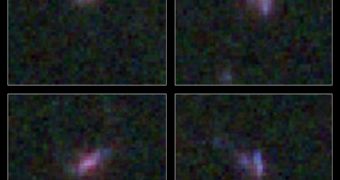For quite some time now, investigators have been hard at work in determining how the growth of supermassive black holes determines the growth of their host galaxies, and vice-versa. Recently, a new study indicated that even small, unremarkable galaxies can harbor the dark behemoths.
Until now, experts believed that smaller galaxies could only contain small-sized black holes at their core, given the feedback mechanisms that control the growth of the dark structures. But the research demonstrated that this is not the case.
The data were obtained by investigators using the Wide Field Camera 3 (WFC3) instrument aboard the NASA/ESA Hubble Space Telescope. With its amazing capabilities, the camera discovered very distant galaxies, of relatively low mass, which contained supermassive black holes.
According to investigators, this discovery has significant implications, such as the fact that black holes appear to be capable of forming in their host galaxies when the latter are still in their infancy. The clear correlation between these two structures has yet to be established.
The mystery is a chicken-or-the-egg-type dilemma. Astronomers know that galaxies and black holes can promote or inhibit each other's growth, but exactly which of them initiates the correlation remains an ardent question.
Astronomers suspect that the key to answering this question lies in the early Universe. This is why they are using telescopes such as Hubble, whose main instruments are extremely well-suited for conducting deep-space investigations.
The newest effort was a part of the Cosmic Assembly Near-infrared Deep Extragalactic Legacy Survey (CANDELS), the team says. Details of the work have been accepted for publication in an upcoming issue of the esteemed Astrophysical Journal.
“These color images were generated from exposures in six different Hubble filters and provide detailed information about the different wavelengths of light coming from the galaxies,” a NASA press release accompanying the study reveals.
“Astronomers say this new study gives them a view of galaxies as they appeared when the Universe was less than a quarter of its current age and shows that central black holes formed at an early stage in galaxy evolution,” the statement adds.
The new study included investigators from the University of California in Santa Cruz, the Steward Observatory, the University of Minnesota, the University of Michigan, Imperial College of London, the New York University, and the Spitzer Science Center at Caltech.
Experts from the National Optical Astronomical Observatories, the Space Telescope Science Institute, the Texas A&M University, the Carnegie Observatories, the Max Planck Institute for Extraterrestrial Physics, in Germany, the Johns Hopkins University and the Goddard Space Flight Center also contributed.

 14 DAY TRIAL //
14 DAY TRIAL //